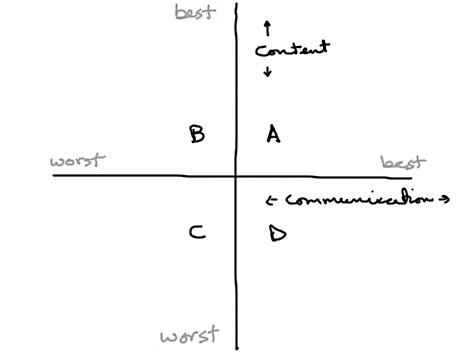
- Monday, November 9th, 2009
- know your audience
-
The independent research portion of the Global Research Analyst Settlementthe research puzzle | This is the third in a series on the settlement. This link will take you to an index of the postings on the topic as they are written. was structured in a way that delivered research reports from independent providers to the clients of the twelve firms that were subject to the settlement (but only for stocks covered by the settling firm, or that it had recently dropped). Since there were no other opportunities for the clients to grill the independent researchers, the report and its accompanying rating comprised the whole of the research product delivered. A future posting will address the ratings on those reports; this one is focused on the reports themselves.
One way to think about the reports is by using this graphic:

Obviously, we would want our assessment of a given piece of research (or a firm’s reports in general) to be as far into the upper right as possible, firmly in quadrant A, with high-quality informational content being presented in an easy-to-understand fashion. Each dimension is critical, but often firms struggle to effectively represent their ideas and how those ideas are specifically the product of their unique research process. There are many firms in quadrant B — those that have work of value but that haven’t figured out how to effectively communicate it. Quadrant C is to be avoided at all costs. Those providers deep into quadrant D can be particularly dangerous, in that they are good at presenting ideas, but there is little of substance behind them.
Each of these attributes is a mere representation of many considerations. Quality of “content” can be debated at length, and there’s a real “know it when you see it” element in play, since there are so many avenues of research that are fruitful. (The next posting will delve further into that due diligence.) Communication is lower on the priority list for most firms, which results in many of them defaulting to industry norms for research reports. That’s too bad, since the average report isn’t very good.
To further mess up the works, let’s add a third dimension to the chart: institutional users of the research versus retail users. Suddenly, things change dramatically, and a firm’s quality of presentation might be evaluated differently for one class of users than the other (or for financial advisors, who are generally “in between”). Even a judgment on the quality of the analysis might change, since more experienced users of the research would understand the nature of that research, how it should be used, where it might go wrong, and where else to look to supplement the information. Others don’t have that perspective. A given piece of research, looked at in isolation, might be judged as being of lower quality on its own than if viewed within a mosaic of other sources.
Which brings us to a key issue when judging the benefits of the settlement. Generally speaking, it was crafted to redress industry practices that were most damaging to those least aware of how business was done and most likely to take things at face value, i.e., individual investors. Yet the settling firms had different mixes of retail and institutional clients. It didn’t matter; the same rules applied to all of the firms, and at a given firm, the same independent research was supplied to all of the clients, retail and institutional. This had a significant impact in many ways, including the extent to which the research was used throughout the settlement.
The research reports produced by the independent firms usually were honed to some degree in advance of the settlement, part of the process of winning the business. A few providers did surveys and focus groups about what users were looking for from their research, and made adjustments in response. (To my knowledge, all of those targeted retail investors.) Other changes came in reaction to ideas, recommendations, or demands from independent consultants who saw shortcomings in the reports. In some cases, consolidators or research consortia also had requirements to be met.
What was lacking is what often is — the ability to target a specific audience. Shooting at the middle of the distribution of users can make a report too basic for the experts and too advanced for the novices. In content and in form (we need to get away from reports that are “frozen in time”the research puzzle | That was the title of a piece I did regarding the switch from paper to PDFs in producing reports.), research reports need to be reworked. Readers of them are looking to solve particular analytical problems, and the next generation of report capabilities must provide a platform for the entire range of users to do just that.
